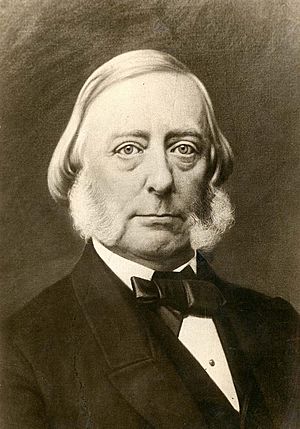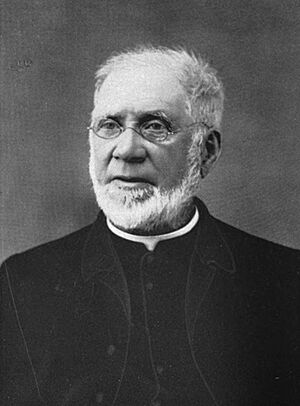History of the University of Kansas facts for kids
The history of the University of Kansas began in 1855. That's when people first dreamed of building a "University of the Territory of Kansas." Nine years later, in 1864, the Kansas Legislature officially created the University of Kansas in Lawrence. Important people like Amos Adams Lawrence and Governor Charles L. Robinson helped make this happen.
The university started with a $15,000 gift and a 40-acre piece of land from Charles Robinson and his wife, Sara. Classes for younger students began in 1866, and college-level classes started in 1869.
Contents
How KU Began: 1850s–1880s

The First Ideas
The idea for a public university in the Kansas Territory was first shared by Governor Andrew Horatio Reeder on July 3, 1855. He told lawmakers that education was important for good government. After his speech, they created a plan for schools and approved a charter for a "University of the Territory of Kansas." This university was planned for Douglas, Kansas, but it was never built.
People in Lawrence had also thought about opening a private college in their town since 1854. Charles Robinson, a member of the New England Emigrant Aid Company, told Amos Adams Lawrence that they would start a college on top of Hogback Ridge (now Mount Oread). By 1856, no private college was built, but Lawrence residents still hoped to create one. They also hoped it could become the state's university.
On Christmas Day in 1856, a group of Lawrence leaders decided it was time to create a college. They chose fifteen trustees to lead it. They also planned to ask Congress for land. They thought they would need $100,000 to start the college, mostly from outside Kansas. In January 1859, the territorial legislature approved a private "University of Lawrence." However, the private college was never built.
Making KU Official
In 1859, the Wyandotte Constitution, which made Kansas a state, included plans for a state university. In 1861, the first Kansas state legislature tried to create the university in Manhattan, Kansas, using the buildings of Blue Mont Central College. But Governor Charles Robinson, from Lawrence, stopped this plan.
In 1862, another attempt to put the university in Manhattan failed. Then, on February 16, 1863, the state accepted Manhattan's offer of the Blue Mont College buildings. This led to the creation of the state's land-grant college there, which became Kansas State University.
However, the legislature said Manhattan's college was different from a "state university." So, on February 20, 1863, Kansas Governor Thomas Carney signed a law creating the state university in Lawrence. The law said Lawrence had to provide a $15,000 fund and at least 40 acres of land for the university. If Lawrence didn't do this, Emporia would get the university instead.
The chosen spot for the university was a hill called Mount Oread. This land belonged to former Governor Charles L. Robinson. Robinson and his wife, Sara, traded their 40 acres to the State of Kansas for other land. Amos Adams Lawrence gave $10,000 of the needed money. The people of Lawrence raised the rest. On November 2, 1863, Governor Carney announced that Lawrence had met the conditions. On March 1, 1864, the University of Kansas was officially created.
The school's Board of Regents met for the first time in March 1865. This is the date KU uses as its founding. Work on the first building, Old North College, began later that year. On July 19, 1866, the Board of Regents chose KU's first three teachers.
The University of Kansas officially opened on September 12, 1866. It had 26 girls and 29 boys in its preparatory school. College-level classes started in 1869. The first four students graduated in 1873. KU was one of the first public colleges in the United States to welcome both women and men equally.
From these early days, a friendly competition began with Kansas State, the oldest public college in Kansas.
In April 1874, the school's first student publication, Observer of Nature, was released. In March 1878, former Chancellor James Marvin started the school's first "campus beautification" project. Over 300 trees were planted, creating an area now known as "Marvin Grove."
The "Rock Chalk Jayhawk" Cheer
In May 1886, professor Edgar Henry Summerfield Bailey suggested the cheer that would become the famous "Rock Chalk Jayhawk, K.U.” chant. He first created it for the KU science club. His version was "Rah, Rah, Jayhawk, KU" repeated three times. Later, the "rahs" were changed to "Rock Chalk." This name comes from "chalk rock," a type of limestone found on Mount Oread, where the Lawrence campus is.
Over time, the chant became known worldwide. Former U.S. president Theodore Roosevelt called it the "greatest college chant he'd ever heard." In 1920, the King of Belgium asked for a typical American college chant at the Olympic Games. The athletes at the Games agreed to use the Rock Chalk chant.
Growing the Campus: 1890s–1910s
New Buildings and Discoveries
In 1893, the Kansas Legislature provided $50,000 to build a new physics and electrical engineering building. This building looked like a French chateau and is now called "old" Blake Hall. The next year, the university's library, Spooner Hall, was finished and opened. It is the oldest building still standing on the KU campus. In 1895, physics professor Lucien I. Blake sent the first long-distance ship-to-shore message using underwater wireless technology.
In March 1898, lightning struck the engineering building and the heating plant. This caused big fires that destroyed both buildings. Because of this, Kansas City businessman George Fowler gave $18,000 to rebuild. The new building was called the Fowler Shops. Today, it's Stauffer-Flint Hall, home to the journalism school.
Starting in 1910, electric trolleys began running through Lawrence and the KU campus. In the same year, Marvin Hall became the School of Engineering. Haworth Hall was dedicated for the geology and mineralogy departments. A year later, a special event marked the completion of Potter Lake. On February 8, 1912, a group of KU women started the Women's Athletic Association, the first of its kind at the school. William B. Thayer and his wife also gave their art collection, worth $150,000, to KU.
KU in the Mid-20th Century: 1920s–1940s
Sports, Discoveries, and Rights
In 1921, Memorial Stadium was built to replace McCook Field. The football team still plays there, making it the seventh oldest college football stadium in the United States.
On May 13, 1923, William Allen White became the first KU graduate to win a Pulitzer Prize. He won it for his newspaper article “To An Anxious Friend,” where he defended free speech. The School of Business was created in 1924. The first campus union building, a community center, was built in 1926.
On February 18, 1930, future KU graduate Clyde Tombaugh announced he had discovered the planet Pluto. Later in 1930, the current Snow Hall was finished. In 1932, Pete Mehringer, a famous KU football and wrestling star, qualified for the 1932 Summer Olympics.
A big step for civil rights happened on August 8, 1938. After pressure from Kansas Governor Walter Huxman and civil rights leaders, the Kansas Board of Regents voted to stop rules that had prevented Black students from finishing their education at the KU School of Medicine. The current chancellor's home, "The Outlook," was finished in 1939, thanks to Elizabeth Watkins. Danforth Chapel was officially opened in April 1946.
In January 1946, the University of Kansas Press was created. This publishing house later joined with other Kansas universities to become the statewide University Press of Kansas.
Modern KU: 1950s–Present
Growth and Achievements
To honor the 276 KU men and women who died in World War II, the Memorial Carillon and Campanile were dedicated on May 27, 1951. In 1954, the debate team won their first National Debate Tournament. Allen Fieldhouse was dedicated on March 1, 1955. The KU basketball team won its only home game of the season that same night. In 1968, former senator Robert F. Kennedy gave speeches for his presidential campaign at both KU and K-State.
In early 1970, a firebomb exploded in the Kansas Union, causing almost $1 million in damage. The School of Nursing was created in 1974 as part of the KU Medical Center. The debate team continued to succeed, winning the National Debate Tournament in 1970 and 1976. On February 21, 1978, former U.S. President Gerald Ford dedicated the new KU School of Law, Green Hall.
Later Years: 1980s-1990s
In 1983, the debate team won the National Debate Tournament for the fourth time. KU dedicated its Vietnam Memorial in 1986. It was the first university in the United States to build such a monument. On June 15, 1991, lightning struck Hoch Auditorium, causing a fire that destroyed the building in less than an hour.
In 1993, the KU Edwards Campus was created in Overland Park, Kansas. It was made to help adults get college degrees and better education. The Edwards campus started offering programs in psychology, public administration, social work, and engineering management.
2000s to Today
The football team, led by coach Mark Mangino, won the 2008 Orange Bowl. They finished that season with 12 wins and only 1 loss.
In 2009, the debate team won the National Debate Tournament for the fifth time in KU's history. Also in 2009, Bernadette Gray-Little became the first woman and first African American to be the chancellor at the university. Gray-Little retired on June 30, 2017.
Images for kids
-
The 1899 University of Kansas basketball team, with Dr. James Naismith at the back right.




